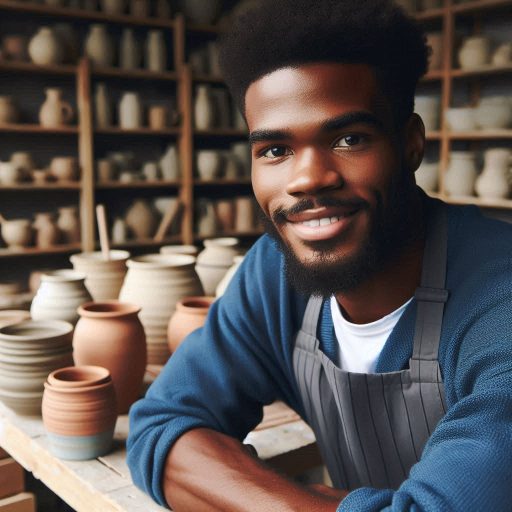Introduction
Ceramic art involves shaping clay into functional or decorative objects through firing and glazing.
It is a form of craftsmanship that has been practiced for centuries, blending creativity and technique.
In ceramic art, artists use various methods such as hand-building, wheel-throwing, and sculpting to create pieces that reflect their vision.
Developing a unique style in ceramic art is essential for standing out in a competitive field.
A distinctive style helps artists express their individuality, making their work recognizable.
It not only sets them apart but also adds value to their creations.
Collectors and galleries often seek artists with a signature approach, as it showcases consistency and mastery.
Crafting a personal style involves experimenting with different techniques, materials, and forms.
It requires a deep understanding of the craft and a willingness to push boundaries.
By continuously refining their work, artists can evolve their style and contribute something new to the art world.
This creative evolution also invites dialogue and interest from the broader artistic community, further enhancing their reputation.
In ceramic art, a unique style is more than just aesthetics‘it is a personal language that communicates the artist’s story, inspiration, and vision.
Developing this identity is crucial for long-term success and recognition.
Researching existing styles
When it comes to creating a unique style in ceramic art, one of the most important steps is to conduct thorough research.
By studying existing styles, techniques, and trends, artists can gain inspiration and develop their own signature aesthetic.
Studying different artists and their techniques
To create a unique style in ceramic art, researching existing styles is essential.
Start by studying different artists and their techniques.
Examine the works of ceramic masters, both historical and contemporary.
Pay attention to how they shape, glaze, and fire their pieces.
This exploration helps you understand the range of possibilities and inspires new ideas.
Transform Your Career Today
Unlock a personalized career strategy that drives real results. Get tailored advice and a roadmap designed just for you.
Start NowLearn about their approaches, materials, and influences.
Take notes on the specific elements that resonate with you.
Analyzing historical and contemporary ceramic art
Next, analyze historical and contemporary ceramic art.
Historical pieces showcase traditional methods and cultural influences, providing a strong foundation for your work.
Ancient civilizations like the Chinese, Greek, and Mayan cultures each contributed to the evolution of ceramic art.
Contemporary ceramic art, on the other hand, reflects modern trends and experimental approaches.
Both perspectives offer valuable insight into the craft‘s development and the constant interplay between tradition and innovation.
Identifying common themes and trends
As you research, identify common themes and trends within the ceramic art community.
Look for recurring patterns, colors, and forms.
Pay attention to how artists interpret themes like nature, identity, and symbolism in their work.
By recognizing these trends, you can discover gaps where your voice and style can emerge.
Use this research to push beyond commonalities and create something truly original.
In summary, researching existing styles by studying artists, analyzing historical and contemporary art, and identifying trends forms the foundation for developing your unique ceramic voice.
Combine your observations with personal creativity to create something that stands out while acknowledging the rich history of ceramic art.
Read: Understanding Glazes and Firing Techniques
Experimenting with techniques
When it comes to creating a unique style in ceramic art, one of the most exciting aspects is experimenting with different techniques.
By pushing the boundaries of traditional methods and embracing unconventional approaches, artists can truly make their mark in the world of ceramics.
Trying out different pottery techniques
One way to create a unique style in ceramic art is by exploring various pottery techniques.
Whether it’s hand-building, wheel-throwing, or sculpting, each technique offers a different way to manipulate clay and create stunning works of art.
Showcase Your Business Today
Reach thousands of readers actively exploring professional services. Publish your business profile and grow your audience now.
Publish NowBy experimenting with different techniques, artists can discover new ways to express themselves and bring their artistic vision to life.
Using various tools and materials
In addition to experimenting with different techniques, artists can also create a unique style by using various tools and materials in their work.
From traditional tools like pottery wheels and kilns to more unconventional items like found objects and natural materials, the possibilities are endless.
By thinking outside the box and incorporating unexpected elements into their pieces, artists can create one-of-a-kind works that stand out from the crowd.
Incorporating unconventional methods
One of the most effective ways to create a unique style in ceramic art is by incorporating unconventional methods into the creative process.
This could mean using alternative firing techniques, experimenting with unusual glazes, or even incorporating non-traditional materials into the clay.
By pushing the boundaries of what is considered traditional in ceramic art, artists can challenge the status quo and create truly original works that reflect their personal style and vision.
In fact, when it comes to creating a unique style in ceramic art, experimentation is key.
By trying out different techniques, using various tools and materials, and incorporating unconventional methods, artists can push the boundaries of traditional ceramic art and create truly original works that reflect their personal style and vision.
So don’t be afraid to step outside your comfort zone and embrace the unknown ‘ you never know what amazing creations you might discover along the way!
Read: Balancing Creativity and Business in Ceramic Art
Finding inspiration
When it comes to creating a unique style in ceramic art, finding inspiration is key.
Artists often draw from various sources to fuel their creativity and develop their own distinctive aesthetic.
Here are some tips on how to find inspiration to enhance your ceramic art:
Exploring Different Sources of Inspiration
To create a unique style in ceramic art, it’s essential to explore a wide range of sources of inspiration.
Look beyond traditional art forms and delve into other disciplines such as architecture, fashion, and photography.
By exposing yourself to diverse influences, you can discover new ideas and approaches that will set your work apart.
Drawing Ideas from Nature, Culture, and Personal Experiences
Nature, culture, and personal experiences are rich sources of inspiration for ceramic artists.
Take a walk in nature, visit museums and galleries, or reflect on meaningful moments in your life to spark ideas for your artwork.
By drawing from these sources, you can infuse your ceramic art with depth and meaning.
Keeping a Sketchbook for Ideas and References
One of the most effective ways to capture and develop your ideas is by keeping a sketchbook.
Use it to jot down thoughts, sketch preliminary designs, and collect references that inspire you.
A sketchbook is a handy tool for recording your creative process and refining your concepts as you work towards creating a unique style in ceramic art.
By exploring different sources of inspiration, drawing ideas from nature, culture, and personal experiences, and keeping a sketchbook for ideas and references, you can cultivate a distinctive style in your ceramic art that reflects your individuality and creativity.
Read: Networking Tips for Emerging Ceramic Artists

Developing a signature style
Combining different elements to create a unique look
When it comes to creating a unique style in ceramic art, it’s essential to experiment with different elements.
This can include exploring various textures, shapes, colors, and techniques.
By combining these elements in unexpected ways, you can create a distinctive look that sets your work apart from others.
Consider incorporating elements from different styles or traditions into your ceramic art.
This could mean drawing inspiration from nature, architecture, or cultural symbols.
By blending these diverse influences, you can develop a style that is truly your own.
Embracing imperfections and quirks
One of the keys to developing a unique style in ceramic art is embracing imperfections and quirks.
Instead of striving for perfect symmetry or flawless finishes, allow room for spontaneity and experimentation in your work.
This can create a sense of character and personality that sets your pieces apart.
Don’t be afraid to let mistakes or unexpected outcomes guide your creative process.
Sometimes, it’s these imperfections that lead to breakthroughs in your style and technique.
Embrace the unexpected and see where it takes you in developing your signature look.
Refining and practicing to perfect the style
Refining your style in ceramic art takes time and dedication.
It’s important to continually practice and experiment with new techniques to hone your skills.
By refining your craftsmanship and attention to detail, you can elevate your work to new levels of artistry.
Showcase Your Business Today
Reach thousands of readers actively exploring professional services. Publish your business profile and grow your audience now.
Publish NowStudy the work of other ceramic artists who inspire you and analyze what makes their style unique.
This can help you identify aspects of your own work that you want to refine or improve upon.
By seeking feedback from peers or mentors, you can gain valuable insights on how to perfect your signature style.
In short, developing a unique style in ceramic art requires a balance of experimentation, embracing imperfections, and continuous refinement.
By combining different elements, embracing quirks, and dedicating time to practice, you can create artwork that is truly one-of-a-kind.
Remember, your style is a reflection of your creativity and vision, so don’t be afraid to let it shine through in your ceramic art.
Read: How to Sell Your Printmaking Art Online
Seeking feedback and critique
Sharing work with other artists and peers
Sharing your ceramic work with other artists and peers helps broaden your perspective.
Engaging with others allows you to see your work from fresh viewpoints.
By exposing your art to different interpretations, you can better understand its impact.
Peer feedback also fosters a sense of community, which is vital for growth.
Welcoming constructive criticism
Welcoming constructive criticism is essential for improving your craft.
Criticism may feel uncomfortable, but it drives artistic evolution.
Accepting feedback with an open mind can push you to explore new techniques.
You may discover areas in your work that need improvement or even spark fresh ideas.
Using feedback to improve and evolve the style
Using feedback to improve and evolve your style will enhance your artistry.
Critique should not discourage you but inspire you to refine your approach.
Incorporating suggestions allows you to transform weaknesses into strengths.
Over time, these improvements will reflect in your evolving, unique style.
This collaborative process of sharing, welcoming critique, and applying feedback continuously enhances your skills.
Reaching out to trusted peers fosters creative innovation.
Building a brand around the style
In order to establish a unique style in ceramic art, it is important to build a brand that is recognizable and distinct.
This can be achieved through consistent branding elements such as a logo, color palette, and visual aesthetic that reflects the artist’s signature style.
Creating a Portfolio Showcasing the Unique Style
A portfolio is an essential tool for showcasing your unique style in ceramic art.
It allows potential clients and collaborators to see a curated selection of your work and understand your artistic vision.
- Select your best pieces that exemplify your unique style and display them in a professional portfolio.
- Include high-quality images of your work that highlight the intricacies and details of your ceramic art.
- Write artist statements or descriptions for each piece that explain the inspiration and techniques behind your work.
Establishing an Online Presence Through Social Media and Websites
To reach a wider audience and promote your unique style in ceramic art, it is essential to have a strong online presence through social media and websites.
This allows you to connect with collectors, art enthusiasts, and potential clients from around the world.
- Create professional profiles on social media platforms such as Instagram, Facebook, and Pinterest to showcase your work and interact with followers.
- Launch a website that showcases your portfolio, artist bio, upcoming exhibitions, and contact information for inquiries.
- Engage with your audience through regular updates, behind-the-scenes glimpses of your creative process, and engaging content that showcases your unique style.
Collaborating with Galleries and Art Shows to Promote the Work
Collaborating with galleries and art shows is a great way to promote your unique style in ceramic art and gain exposure in the art world.
It allows you to showcase your work to a wider audience and connect with curated collectors and art lovers.
- Research and reach out to galleries that align with your artistic style and submit your portfolio for consideration.
- Participate in art shows, exhibitions, and art fairs to showcase your work and connect with fellow artists and art enthusiasts.
- Collaborate with curators and art professionals to curate exhibitions that highlight your unique style and artistic vision.
See Related Content: Interactive Media Designer: Job Description
Conclusion
Creating a unique style in ceramic art is crucial for artists to stand out in a crowded market.
It is essential for artists to experiment and explore various techniques to develop their own signature style.
By honing their skills and embracing creativity, artists can differentiate themselves and leave a lasting impression on art enthusiasts.
Ultimately, the journey of creating a unique style in ceramic art is both challenging and rewarding for artists who are willing to push boundaries.
[E-Books for Sale]
The Big Book of 500 High-Paying Jobs in America: Unlock Your Earning Potential
$19.99 • 500 High-Paying Jobs • 330 pages
Explore 500 high-paying jobs in America and learn how to boost your career, earn more, and achieve success!
See All 500 High-Paying Jobs of this E-Book
1001 Professions Without a Degree: High-Paying American Jobs You Can Start Now
$19.99 • 1001 Professions Without a Degree • 174 pages
Discover 1001 high-paying jobs without a degree! Unlock career tips, skills, and success strategies for just $19.99!




